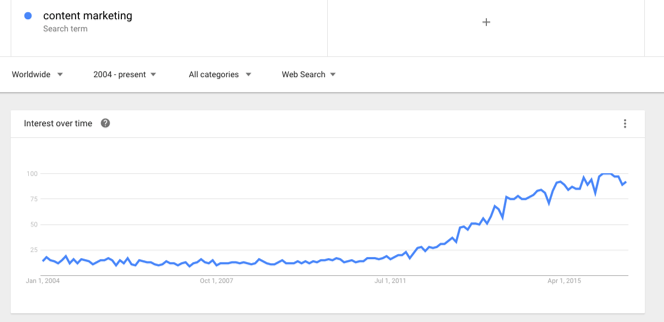Content marketing is not an easy definition to pin down. When you Google this term, over 49 million search results come back. And this trending term has grown 500% in the past five years.
I like the way the Content Marketing Institute puts it best:
Content marketing is a strategic marketing approach focused on creating and distributing valuable, relevant, and consistent content to attract and retain a clearly-defined audience — and, ultimately, to drive profitable customer action.
Content includes anything produced, whether written, visual, or spoken, by your organization or a representative thereof. It covers a very wide array of things. Marketing content includes your website and anything that appears on it, emails, marketing materials like flyers or advertisements, trade shows, and hosted educational events like a webinar or live presentation. All of it counts.
Why Do B2B Companies Need Content Marketing?
Based on those definitions, it’s obvious to marketers like me why B2B companies need content marketing. The definition of content marketing covers three major points that explain this:
Creates and distributes valuable, relevant, and consistent content:
Relevance is created by meeting your ideal buyer when they’re ready to buy, where they’re ready to buy, and with the right information that they’re looking for.
Attract and retain a defined audience:
To me, this rings especially true for B2B companies. You’re not just marketing to anyone; you’re marketing to buyers at other companies. Teams of 7-20 people are involved in the buying process, and the sales cycle could take 6 to 18 months. Your very targeted audience is doing huge amounts of research prior to making a decision. And, they’d rather conduct the research themselves, when they’re ready. How do I know? Take a look at the data:
80% of business decision-makers would rather get company information from a series of articles than from an advertisement.

In 2007, it took 3.68 cold call attempts to get a response. Today, it takes at least 8.
More than half of respondents to the 2015 B2B Buyer’s Survey by DemandGen said that LinkedIn (61%) and blogs (58%) were important resources during their initial learning process, followed by YouTube/Vimeo, Facebook, Google+ and Twitter.
Drives profitable customer action:
I’ll refer back to the DemandGen survey I talked about before, because it summed up this point best:
"When it comes to the content that influences buying decisions, B2B buyers are looking for the facts. 86% of the respondents to the 2015 B2B Buyer’s Survey reported that vendor-focused content, such as case studies and product data sheets are triggers that influence their purchase decisions," says the report.
75% of respondents also think positively about thought leadership content such as white papers and infographics; these specifically were among the top pieces of content that they review during the buying process.
In addition, a better mix of content throughout the research and decision-making stages was also important. According to the report, "content that built a business case or showed clear ROI for the purchase was cited as somewhat or very important by 83% buyers surveyed."
When it comes to driving profitable consumer action, content marketing both during the research process and during the sales process play a huge role. While buyers are researching, having educational, relevant content online and available is hugely important. Once a buyer is ready to talk to sales, giving the buyer tailored information that backs up ROI is absolutely essential. Often, marketing is the team driving that research and needs to arm sales with the data they’ll find useful to create that profitable action.
Why Aren't B2B Organizations Using Content Marketing More?
B2B marketers cite lack of time (69%), producing enough content (55%) and producing the kind of content that engages (47%) as their top three content marketing challenges, according to Content Marketing Institute.
60% of B2B marketers identify lead generation as their top online marketing challenge, says eMarketer.
Proving the ROI of content marketing is also a struggle by many who don’t have the tools in place to do so. Since this is one of the top goals by B2B marketers this year, it's clear that not having an effective way to measure content marketing ROI is holding up a lot of thought leaders from sharing content online.
The Top 3 Things to Know to Be Successful at Content Marketing
Thanks to the advice from the Content Marketing Institute, this is how Jül creates its content marketing strategy and publishes content, as well:
1. Create an editorial mission statement. For most B2B organizations, it’ll address the following:
- The core audience (also known as a persona) target: the type of person you can help most with your content
- What will be delivered to the audience: the types of information you will provide through your content
- The desired outcome for the audience: things your audience will be able to do once they have consumed your content
So, while you may have a few different personas, your editorial mission statement should remain true for all personas.

After a brainstorming session and before a piece of content goes on the calendar, we ask ourselves:
- Will this help to advance the practice of inbound marketing for B2B businesses (i.e., does it speak to our reason for existing)?
- Will it be actionable to marketers and executives at small- to mid-sized brands (i.e., our target audience)?
- Will it help us grow and maintain our email list or nurture those on the list to other activities (i.e., does it help us meet our key goal)?
You’ll accomplish the mission in various ways; that’s where step two comes in.
2. Have a documented plan to meet defined goals. This requires you to manage content pieces as business assets.
- Creating goals for your content to meet, such as lead generation, engagement numbers, and target audience usefulness, is the first step.
- Secondly, creating a content marketing plan - also known as a content strategy - puts a plan in place for the “creation, publication, and governance of useful, usable content,” says Kristina Halvorson of Brain Traffic.
3. Create engaging content for your audience.
This is the big one, guys. Engaging to your audience will not be engaging for everyone. Your company may sell machinery that makes coffee filters. While the rest of the world may hit the snooze on your content, coffee filter-maker machinery buyers - the ones actually doing the research and purchasing - are engaged and want more of what you have to offer. Give them what they want - specs, video, pro/con lists, evaluations, the works. Make it engaging to them.






